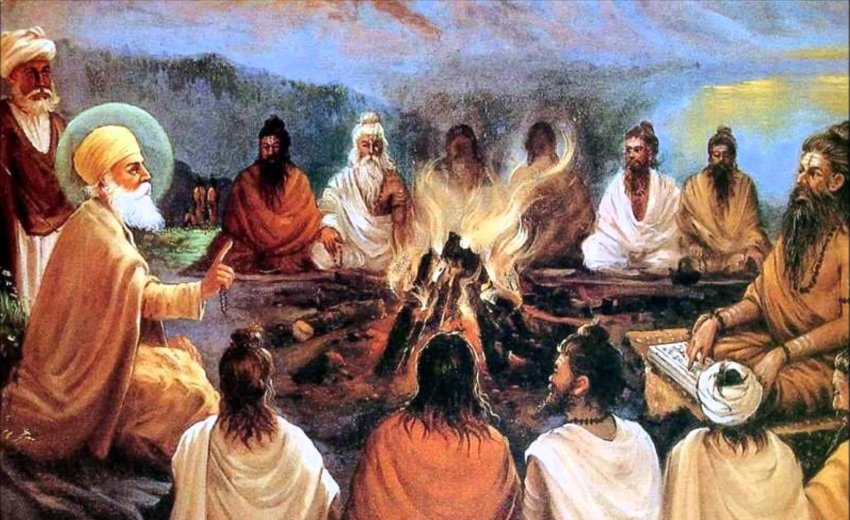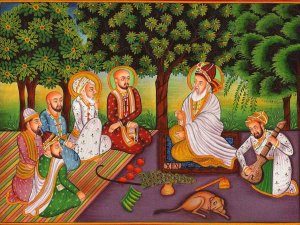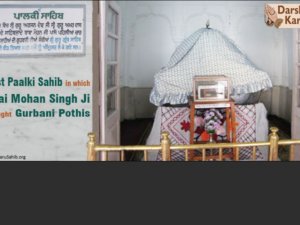Siddh means a mystic adept in yoga who has attained yogic powers over the five elements and gosht means discourse or dialogue. It is one of Guru Nanak’s long compositions and is recorded in Sri Guru Sahib Granth Sahib on pages 938 to 946. It is a recollection by Guru Nanak of major points of the discourses that took place between the Sidhas and Guru Nanak during his visit to Gorakh Matta, Sumer Parbat and Achal Vatala now called Batala while he was touring different parts of the world to teach people. Bhai Gurdass has also mentioned about these discourses in his vaars. Sidh Gosht is a profound composition of Guru Nanak describing his philosophy vis-a-vis the Siddhas and more.
Time of its Being Composed, its Language and Style
The text does not provide any clue as the time and place of its composition. According to Prof. Sahib Singh in his book ‘Sri Guru Granth Sahib Darpn’ part 7th page17, it was composed in 1539 at Kartarpur after Guru Nanak visited the fair at Achal Vatala. Its language is Sadh Bhasha, language used by the Hindu saints and is difficult for a common man to fully understand it. It contains many technical terms used by Siddh Yogis. Brevity is its main characteristic and many symbols and metaphors have been used. Siddh Gosht contains seventy three stanzas. Most of these stanzas contain questions raised by the Siddhas and their answers given by Guru Nanak. These questions answers bring out the philosophy of the Sidddhas and teachings of Guru Nanak.
According to S. Manmohan Singh, author of ‘Sri Guru Granth Sahib English Punjabi Translation,” Vol.6, there are 89 questions and answers. These cover a wide variety of subjects such as how to live a pure life, how to achieve salvation, renunciation, origin of the world, significance of truthfulness, meditation on His Name and definition of a true Yogi etc. Siddh Gosht brings out strikingly the crux of the philosophy, way of life and teachings of Siddhas and Guru Nanak. Keeping in view the length of the article, only a few main topics will be dealt with in this article.
Central Idea: Central idea of the whole text is given by Guru Nanak in the following couplet just after the first stanza of the text. This is marked as rehaao or pause. This couplet advises the Siddhas that renouncing the world and wandering in the woods and mountains will be fruitless; it is through the True Name, i.e. obeying the commands of the Lord, that life becomes pure and purposeful, and one gets emancipation:
ਕਿਆ ਭਵੀਐ ਸਚਿ ਸੂਚਾ ਹੋਇ ॥ਸਾਚ ਸਬਦੁ ਬਿਨੁ ਮੁਕਤਿ ਨ ਹੋਇ॥ (SGGS:938) ‘What is the use of wandering around? Purity comes only through Truth. Without the True Name, no one finds liberation.’
How to Live a Pure Life
In the 4th stanza, the yogi Charpat, who belonged to the Nath tradition, asked Guru Nanak how to swim across successfully ocean of life and how to get libration by remaining detached while still living:
ਦੁਨੀਆ ਸਾਗਰੁ ਦੁਤਰੁ ਕਹੀਐ ਕਿਉ ਕਰਿ ਪਾਈਐ ਪਾਰੋ ॥ (SGGS:938) ‘The world-ocean is treacherous and impassable; how can one cross over it?’
In the next stanza Guru Nanak replies that one can achieve libration by remaining detached from the impurities of life while living in this world and by making the human heart the abode of the Supreme Being and not by renouncing the world:
ਜੈਸੇ ਜਲ ਮਹਿ ਕਮਲੁ ਨਿਰਾਲਮੁ ਮੁਰਗਾਈ ਨੈ ਸਾਣੇ ॥
ਸੁਰਤਿ ਸਬਦਿ ਭਵ ਸਾਗਰੁ ਤਰੀਐ ਨਾਨਕ ਨਾਮੁ ਵਖਾਣੇ ॥ (SGGS:938)
‘As the lotus flower floats untouched upon the surface of the water, and as the duck swims through the stream; so with one's consciousness focused on the Guru’s words and uttering the Name , one can cross over the terrifying world-ocean. O Nanak.’
Sidhas admire their Faith and Persuade Nanak to join them
Sidhas proclaim the importance of renunciation, outer grabs and rituals. They feel proud of their life away from cities living on roots and underground bulbs. They persuade him to put on their dress, adopt their symbols and join them:
ਹਾਟੀ ਬਾਟੀ ਰਹਹਿ ਨਿਰਾਲੇ ਰੂਖਿ ਬਿਰਖਿ ਉਦਿਆਨੇ ॥
ਕੰਦ ਮੂਲੁ ਅਹਾਰੋ ਖਾਈਐ ਅਉਧੂ ਬੋਲੈ ਗਿਆਨੇ ॥ (SGGS:938)
‘We live in the woods away from stores and highways, among plants and trees. For food, we take fruits and roots. This is the spiritual wisdom which the Yogi uttered.’
ਦਰਸਨੁ ਭੇਖ ਕਰਹੁ ਜੋਗਿੰਦ੍ਰਾ ਮੁੰਦ੍ਰਾ ਝੋਲੀ ਖਿੰਥਾ ॥
ਬਾਰਹ ਅੰਤਰਿ ਏਕੁ ਸਰੇਵਹੁ ਖਟੁ ਦਰਸਨ ਇਕ ਪੰਥਾ ॥ (SGGS:939)
‘Wear the robes of the sect of Yogis who follow Gorakh; put on the ear-rings, begging wallet and patched coat. Among the twelve schools of Yoga, adopt the one, among the six schools of philosophy, ours is the one sect.’
Guru Nanak Rejects the Offer
Guru Nanak rejects the significance of outer garbs, symbols, renunciation and pilgrimage to holy places as the ultimate aim of life . He recommends that they control their passions and fix their mind on He who pervades throughout the universe: He advocates the cultivation of virtues like truth, self restraint and continence:
ਅੰਤਰਿ ਸਬਦੁ ਨਿਰੰਤਰਿ ਮੁਦ੍ਰਾ ਹਉਮੈ ਮਮਤਾ ਦੂਰਿ ਕਰੀ ॥
ਕਾਮੁ ਕ੍ਰਹ ਅਹੰਕਾਰੁ ਨਿਵਾਰੈ ਗੁਰ ਕੈ ਸਬਦਿ ਸੁ ਸਮਝ ਪਰੀ ॥
ਖਿੰਥਾ ਝੋਲੀ ਭਰਿਪੁਰਿ ਰਹਿਆ ਨਾਨਕ ਤਾਰੈ ਏਕੁ ਹਰੀ ॥ (SGGS:939)
‘Let constant absorption in the Guru’s Word deep within be your ear-rings. It eradicates egotism and attachment, discards sexual desire, anger and egotism, and thus one attains true understanding through the Word of the Guru. See the Lord pervading everywhere and treat it as your patched- coat and begging bowl. O Nanak, the One Lord will carry you across.’
The Origin of the World
The Sidhas ask Guru Nanak about the origin of the world and want clarification about the concept of shunya (void.) Nanak replies that before the creation of the world there was no universe, yet it was not an empty void. The Light of the Formless Lord pervaded the three worlds. Guru Nanak’ does not mean nothing or an empty void. There was a state about which one can talk in terms of wonder...
ਆਦਿ ਕਉ ਕਵਨੁ ਬੀਚਾਰੁ ਕਥੀਅਲੇ ਸੁੰਨ ਕਹਾ ਘਰ ਵਾਸੋ ॥ (SGGS:940)
‘What can you tell us about the beginning? In what home did the Profound Lord dwell then? ‘
ਆਦਿ ਕਉ ਬਿਸਮਾਦੁ ਬੀਚਾਰੁ ਕਥੀਅਲੇ ਸੁੰਨ ਨਿਰੰਤਰਿ ਵਾਸੁ ਲੀਆ ॥ (SGGS:940)
‘We can only express a sense of wonder about the beginning. The profound Lord abided deep within Himself then.’
ਗਉਨੁ ਗਗਨੁ ਜਬ ਤਬਹਿ ਨ ਹੋਤਉ ਤ੍ਰਿਭਵਣ ਜੋਤਿ ਆਪੇ ਨਿਰੰਕਾਰੁ (SGGS:941) ‘When the world and the sky did not even exist, the Light of the Formless Lord filled the three worlds. ‘
Yogi, Gurmukh ( Guru-ward) and Manmukh( Self-willed)
From stanzas 23rd to 42nd, there are no questions and answers. In these stanzas, Guru Nanak defines Yogi, Gurmukh and Manmukh. According to Guru Nanak, a true Yogi is not one who renounces the world, wanders in the woods and mountains, but one who effaces ones ego, becomes detached from the impurities of life and enshrines the Lord in ones heart, while a manmukh, the self-willed, is assailed by doubt and wanders in the wilderness. A gurmukh who has his face and mind turned to the Guru remains busy in remembering the Lord:
ਆਪੁ ਮੇਟਿ ਨਿਰਾਲਮੁ ਹੋਵੈ ਅੰਤਰਿ ਸਾਚੁ ਜੋਗੀ ਕਹੀਐ ਸੋਈ ॥ (SGGS:940)
‘He alone is a Yogi, who enshrines the True Lord deep within, eradicates his self-conceit and becomes free of desires.’
ਗੁਰਮੁਖਿ ਨਿਰਮਲ ਹਰਿ ਗੁਣ ਗਾਵੈ ॥ ਗੁਰਮੁਖਿ ਪਵਿਤ੍ਰੁ ਪਰਮ ਪਦੁ ਪਾਵੈ] (SGGS:941)
‘The gurmukh sings the praises of the Immaculate Lord and attains the supreme, sanctified status.’
ਮਨਮੁਖਿ ਭਰਮਿ ਭਵੈ ਬੇਬਾਣਿ ॥ ਵੇਮਾਰਗਿ ਮੂਸੈ ਮੰਤ੍ਰਿ ਮਸਾਣਿ ॥ (SGGS:940) ‘The manmukhs are confused by doubt and wander in the wilderness. Having lost their way, they are plundered; they chant their mantras at cremation grounds.’
How to Realize the Lord
The yogis ask Guru Nanak, “When the Lord has no form, color and garb, how we can know and see Him?” Guru Nanak replies that those who are detached and who are imbued with His Name, i.e. follow His Commands, can see the Lord everywhere:
ਵਰਨੁ ਭੇਖੁ ਅਸਰੂਪੁ ਨ ਜਾਪੀ ਕਿਉ ਕਰਿ ਜਾਪਸਿ ਸਾਚਾ ॥ (SGGS:945)
‘When color, dress and form could not be seen, how could the True Lord be known?’
ਨਾਨਕ ਨਾਮਿ ਰਤੇ ਬੈਰਾਗੀ ਇਬ ਤਬ ਸਾਚੋ ਸਾਚਾ ॥ (SGGS:945)
‘O Nanak, those detached who are attuned to the Naam, the Name of the Lord, always see the Truest of the True.’
In reply to the Siddha’s question, “What is the state of those who are imbued with the Lord?” Guru Nanak replies that who obtain Him are like He from whom they originated.
ਅਨਹਤ ਸੁੰਨਿ ਰਤੇ ਸੇ ਕੈਸੇ ॥ ਜਿਸ ਤੇ ਉਪਜੇ ਤਿਸ ਹੀ ਜੈਸੇ ॥ (SGGS:943)
Of what kind are they who are attuned to the Imperishable Lord?
He replied, 'They are like the Lord, from whom they originated.’
Conclusion
The Siddh Goshti is a compassionate correction to the yogis by Guru Nanak whose aim was to check and curb the egos of the Siddhas and to encourage them to lead simple and pure lives in society, sharing their spiritual knowledge freely with everyone. The Guru has separated the spiritual life from the ritual life. He has built a common highway to God for human beings living in purity.
Guru Nanak has given us a systematic representation of his perception of God, Guru, Naam, Shabad, meditation, and the concept of Gurmukh. Siddh Goshti is relevant even today as it suggests in a simple way how to lead a peaceful and useful life. It shows the imbalance the Siddhas had brought in their social life and explains the real philosophy of Guru Nanak.
Siddhas are the Yogis who renounce worldly living, move to hills or jungles and wander in different places and pilgrimages. They try to show their belief system by symbolism. But Guru Nanak emphasized the need for practical living guided by the Guru and that the way of the householder is the highest way of all. This is the theme that runs all through Siddh Gosht.






